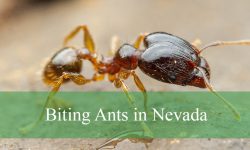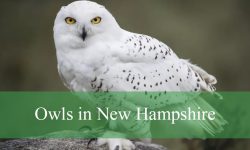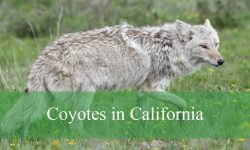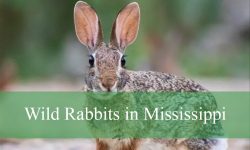South Dakota may not be the first state that comes to mind when thinking about hummingbirds, but each year these tiny jewels of the sky pass through the prairies and woodlands. Birdwatchers across the state eagerly set up feeders and gardens, hoping to catch a glimpse of their dazzling colors and incredible flight skills.
While the Ruby-throated Hummingbird is the most common species found here, several other remarkable hummingbirds make appearances during migration. Some stay briefly to feed on nectar-rich flowers, while others are rare visitors that delight bird enthusiasts lucky enough to spot them.
From the eastern plains to the Black Hills, South Dakota offers unique opportunities to experience the magic of hummingbirds. This guide highlights six species you may encounter, complete with pictures and identification tips to help you recognize these fast-moving wonders.
Types of Hummingbirds Found in South Dakota
Ruby-throated Hummingbird (Archilochus colubris)
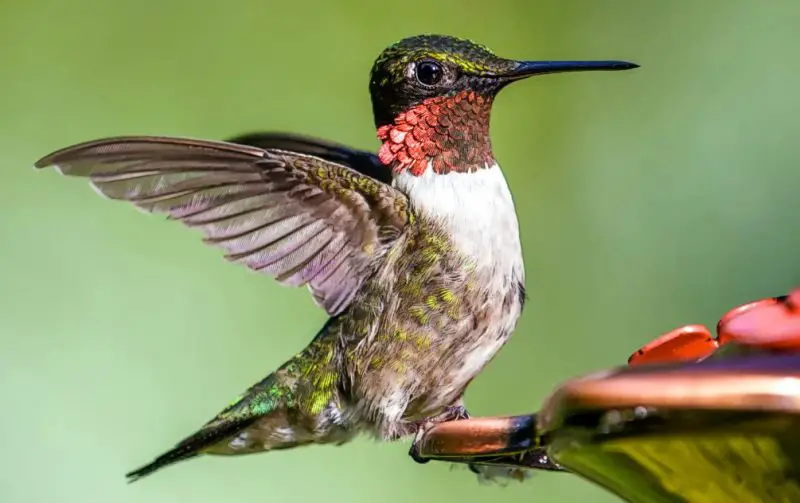
The Ruby-throated Hummingbird is the most common and widespread hummingbird in South Dakota, especially during the summer breeding season. Males are easily identified by their brilliant ruby-red throat patch, which shimmers in the sunlight, while females lack this bright feature and display a more subdued white throat. Both sexes have iridescent green backs and a slender build that allows them to hover effortlessly in front of flowers.
This species is small, typically measuring about 3 to 3.5 inches in length with a wingspan of 4 to 4.5 inches. They are well-known for their rapid wingbeats, which can reach up to 50 times per second, producing the familiar humming sound. The Ruby-throated Hummingbird is a migratory bird, traveling thousands of miles from Central America to North America each year, often crossing the Gulf of Mexico in a single flight.
In South Dakota, Ruby-throated Hummingbirds are usually found in gardens, wood edges, and meadows where nectar-producing flowers are abundant. They also frequently visit backyard feeders filled with sugar water, becoming a favorite among birdwatchers. These birds are highly territorial and will often chase away rivals from their feeding spots, especially during the breeding season.
Their diet consists primarily of nectar, but they also consume small insects and spiders for protein. By visiting countless flowers, Ruby-throated Hummingbirds play an essential role in pollination. They are typically present in South Dakota from late spring through early fall before migrating south in preparation for winter.
Broad-tailed Hummingbird (Selasphorus platycercus)
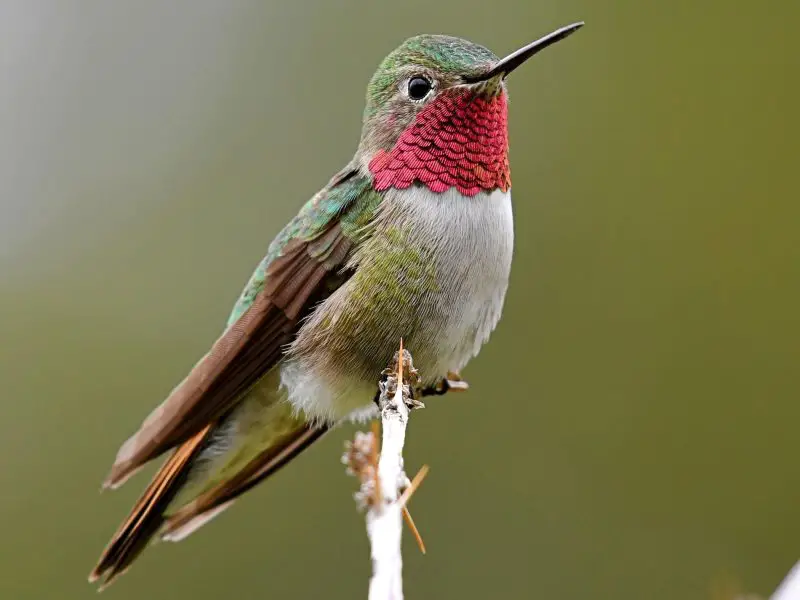
The Broad-tailed Hummingbird is a less common visitor to South Dakota, but it can occasionally be seen in the western regions, particularly near the Black Hills. This species is most easily recognized by the males’ iridescent rose-colored throat and the unique trilling sound made by their wings during flight. Females and immature birds lack the bright throat patch but show green plumage on their backs with pale underparts.
Broad-tailed Hummingbirds measure around 3.5 to 4 inches long and have relatively long tails compared to other species. Their distinctive metallic wing sounds set them apart from other hummingbirds and are often heard before the bird is seen. These hummingbirds are native to higher elevations in the Rocky Mountains but expand their range slightly during migration, which is when they may appear in South Dakota.
They prefer open woodlands, mountain meadows, and areas filled with wildflowers. In South Dakota, spotting one is considered a special treat, as they are not as widespread as Ruby-throated Hummingbirds. They will occasionally visit hummingbird feeders if nectar is available, especially during their migratory journey.
Their diet consists of flower nectar and small insects, which provide essential energy for their long flights. Because they are adapted to cooler mountainous habitats, Broad-tailed Hummingbirds can tolerate colder nighttime temperatures better than many other hummingbird species. This adaptability allows them to survive in environments that would challenge most other hummingbirds.
Rufous Hummingbird (Selasphorus rufus)
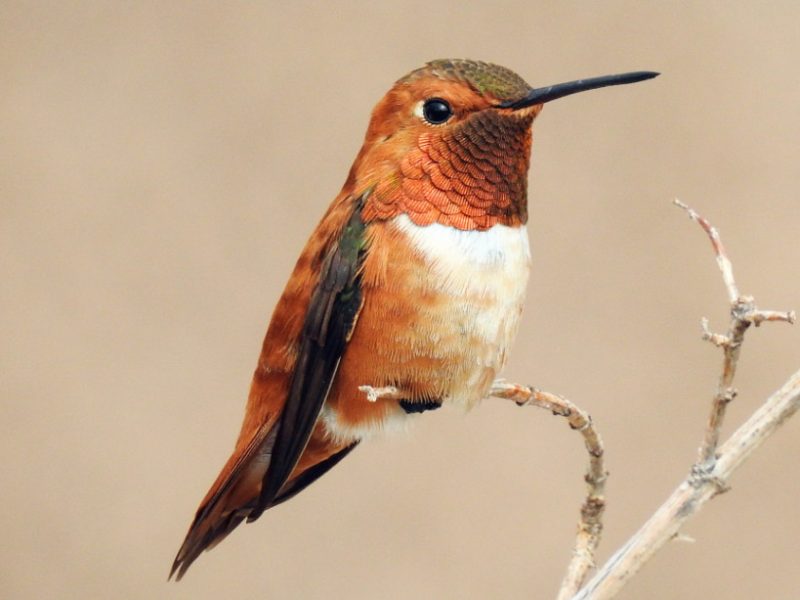
The Rufous Hummingbird is a striking yet aggressive species known for its fiery orange plumage. Males are particularly vibrant, with bright orange backs, sides, and tails, along with a glittering red-orange throat patch. Females are less colorful, displaying greenish backs with rusty flanks and tails edged in rufous tones. This bird’s vivid colors make it one of the most easily recognized hummingbirds in North America.
Rufous Hummingbirds are among the smallest hummingbirds, averaging about 3 inches in length with a wingspan of around 4 inches. Despite their tiny size, they are famous for their bold and territorial behavior. They aggressively chase away not only other hummingbirds but also larger birds and even insects that venture too close to their feeding grounds. This makes them both entertaining and challenging guests at backyard feeders.
In South Dakota, Rufous Hummingbirds are most often seen during migration. They follow one of the longest migratory routes of any hummingbird, traveling from Mexico to as far north as Alaska and back again each year. During these journeys, some individuals pass through the Great Plains, including parts of South Dakota, making late summer and early fall the best times to observe them.
Their diet is similar to other hummingbirds, relying on nectar for quick energy and small insects for protein. Rufous Hummingbirds are particularly adaptable, capable of thriving in a wide range of habitats from mountain meadows to suburban gardens. Their resilience and striking appearance make them a favorite among bird enthusiasts lucky enough to see them in South Dakota.
Calliope Hummingbird (Selasphorus calliope)
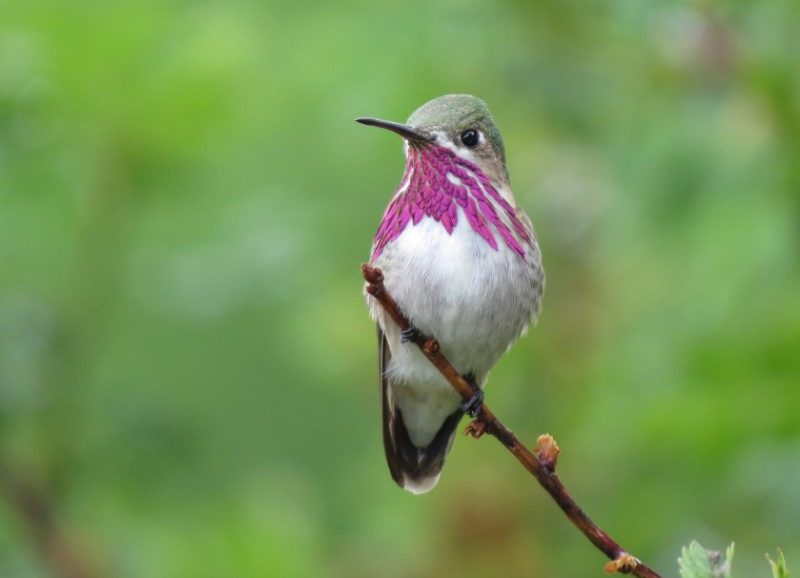
The Calliope Hummingbird is the smallest bird in North America, measuring just about 3 inches in length. Despite its tiny size, it undertakes an impressive migratory journey, traveling thousands of miles from Mexico to the northwestern United States and Canada. Males are especially eye-catching, with a brilliant magenta streaked gorget that fans outward like rays, contrasting beautifully against their white throats. Females and juveniles are more subdued, with green backs and pale underparts.
In South Dakota, Calliope Hummingbirds are considered rare but can be spotted during migration, particularly in the western part of the state. Birdwatchers may catch sight of them in open woodlands, mountain meadows, and even gardens with abundant nectar sources. Their diminutive size often makes them less noticeable compared to larger species, but their distinctive throat markings help with identification.
The Calliope Hummingbird’s small frame gives it an advantage in maneuverability, allowing it to hover and dart quickly between flowers. They are agile fliers and can display surprising aggression when defending feeding territories, especially males during the breeding season. Despite their delicate appearance, these tiny birds are hardy travelers.
Their diet consists of nectar, which fuels their high-energy flight, along with small insects and spiders for protein. Because they are rare visitors to South Dakota, sightings are considered special and memorable for bird enthusiasts. Their presence underscores the incredible diversity of hummingbirds that migrate across the continent.
Anna’s Hummingbird (Calypte anna)
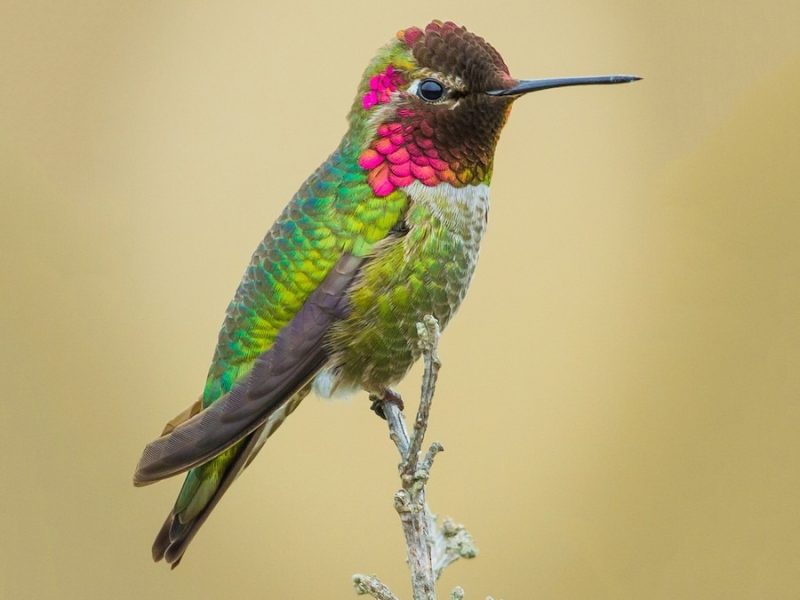
Anna’s Hummingbird is primarily a West Coast species, but it is occasionally recorded as an accidental visitor in South Dakota. Unlike many other hummingbirds that migrate long distances, Anna’s is more sedentary, often remaining in its range year-round. Males are easily identified by their shimmering rose-pink gorget and crown, while females display a duller version of these markings along with a green back and grayish underparts.
This species is slightly larger than most hummingbirds found in the state, measuring around 4 inches long. Their plumage sparkles in direct sunlight, making them one of the most visually striking hummingbirds. Because they are rare in South Dakota, sightings usually occur when individuals stray from their typical range during migration or after storms.
Anna’s Hummingbirds prefer habitats with flowering plants, shrubs, and access to feeders. In South Dakota, they are most likely to be seen near backyard gardens equipped with nectar feeders, particularly during warmer months. Unlike Ruby-throated Hummingbirds, which are regular breeders in the state, Anna’s are strictly visitors.
Their diet includes nectar, tree sap, and small insects. Anna’s Hummingbirds are unique because they are known to sing, producing a series of scratchy, buzzy notes that are unusual for hummingbirds. For birdwatchers in South Dakota, spotting one is a rare but exciting event.
Costa’s Hummingbird (Calypte costae)
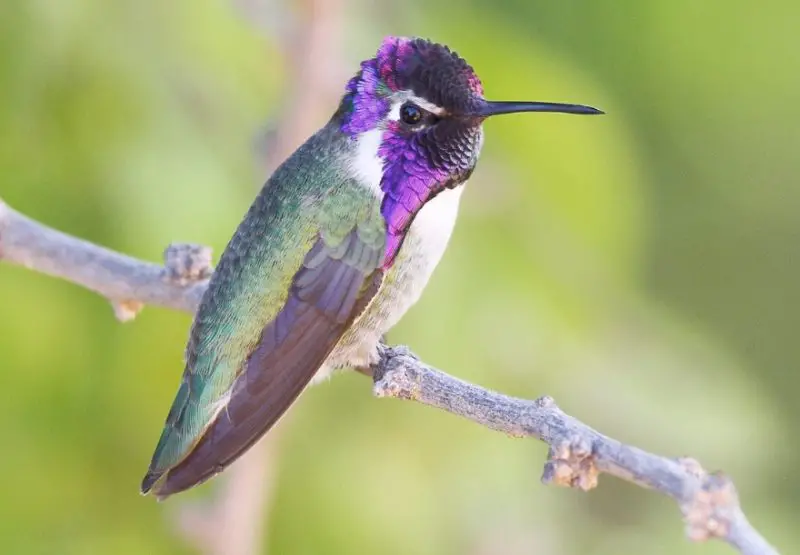
Costa’s Hummingbird is another rare visitor to South Dakota, usually appearing as an accidental sighting far outside its normal southwestern range. Native to the deserts of California, Arizona, and Nevada, this species is recognized by the males’ dazzling purple gorget and crown that flare out dramatically. Females are less vibrant, with greenish backs and whitish underparts.
Slightly smaller than Anna’s Hummingbird, Costa’s typically measures about 3 to 3.5 inches in length. Their striking coloration and desert origins make them an unusual sight in the Great Plains. Most reports in South Dakota are of migrants straying far from their range, often during unusual weather events or shifting migration patterns.
In their native habitats, Costa’s Hummingbirds thrive in desert scrublands and arid landscapes where they feed on cacti blooms and desert flowers. When seen in South Dakota, they are most often found near feeders or flowering plants that provide a temporary food source. Because they are so rare, even a single sighting is notable for birding records.
Their diet is similar to that of other hummingbirds, consisting of nectar and insects. Costa’s Hummingbirds are known for their high-pitched vocalizations and elaborate courtship displays, where males perform dramatic aerial dives to impress females. For South Dakota birdwatchers, encountering a Costa’s Hummingbird is considered a once-in-a-lifetime experience.
Best Time and Places to See Hummingbirds in South Dakota
South Dakota offers birdwatchers wonderful opportunities to observe hummingbirds, but timing and location play a crucial role in sightings. The best time to see hummingbirds in the state is between late spring and early fall, with peak activity during the summer months. Ruby-throated Hummingbirds, the most common species, typically arrive in May and stay until September, while migratory visitors such as Rufous and Calliope Hummingbirds are more likely to appear in late summer.
The eastern half of the state is the most reliable region for spotting Ruby-throated Hummingbirds, particularly in gardens, woodlands, and meadows. In contrast, the western part of South Dakota, especially the Black Hills, is more favorable for catching glimpses of less common species like Broad-tailed and Calliope Hummingbirds. Rare visitors such as Anna’s and Costa’s Hummingbirds may show up unpredictably across the state, often near nectar feeders.
Backyard birdwatchers can increase their chances of attracting hummingbirds by setting up nectar feeders filled with a simple sugar-water solution (one part sugar to four parts water). Planting native, nectar-rich flowers like bee balm, columbine, and trumpet vine also creates a hummingbird-friendly environment. These efforts provide essential stopover fuel for migrating birds and give enthusiasts close-up views of their dazzling colors and behaviors.
Overall, the combination of wildflower meadows, forest edges, and suburban gardens makes South Dakota a rewarding destination for hummingbird watching. Patient observers who time their visits during migration seasons stand the best chance of spotting not only the common Ruby-throated Hummingbird but also the rare and exciting visitors that occasionally pass through.
FAQs About Hummingbirds in South Dakota
What is the most common hummingbird in South Dakota?
The Ruby-throated Hummingbird is by far the most common and widespread hummingbird in South Dakota. It breeds throughout much of the state, especially in the east, and is a regular visitor to backyard feeders during the summer months.
Are there hummingbirds in the Black Hills?
Yes, the Black Hills region offers unique opportunities to see less common species such as the Broad-tailed and Calliope Hummingbirds. These birds are not as widespread as the Ruby-throated Hummingbird but appear in suitable habitats during migration.
Do hummingbirds stay in South Dakota year-round?
No, hummingbirds are migratory birds. They spend their winters in Central America or Mexico and only visit South Dakota during the warmer months. Most hummingbirds leave the state by early fall as they begin their long migration south.
How can I attract hummingbirds to my backyard in South Dakota?
The best way to attract hummingbirds is to set up nectar feeders and plant native flowers that produce abundant nectar. Ensure feeders are cleaned regularly to keep the sugar-water solution fresh. Adding flowers such as trumpet vine, bee balm, and salvia can make your yard more appealing.
Are Rufous Hummingbirds common in South Dakota?
Rufous Hummingbirds are not as common as Ruby-throated Hummingbirds but are regular migrants through South Dakota. They are most often spotted in late summer and early fall as they travel south along one of the longest migratory routes of any hummingbird.



